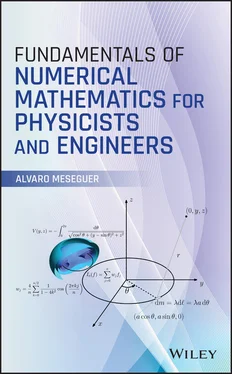This book is mainly written for mathematically inclined scientists and engineers, although applied mathematicians may also find many of the topics addressed in this book interesting. My intention is not simply to give a set of recipes for solving problems, but rather to present the underlying mathematical concepts involved in every numerical method. Throughout the eight chapters, I have tried to write a readable book, always looking for an equilibrium between practicality and mathematical rigor. Clarity in presenting major points often requires the supression of minor ones. A trained mathematician may find certain statements incomplete. In those passages where I think this may be the case, I always refer the rigorous reader to suitable bibliography where the key theorem and its corresponding proof can be found.
Whenever it has been possible, I have tried to illustrate how to apply certain numerical methodologies to solve problems arising in the physical sciences or in engineering. For example, Part Iincludes some practicals involving very basic Newtonian mechanics. Part IIincludes practicals and examples that illustrate how to solve problems in electrical networks (Kirchhof's laws), classical thermodynamics (van der Waals equation of state), or quantum mechanics (Schrödinger equation for univariate potentials). In all the previous examples, the mathematical equations have already been derived, so that those readers who are not necessarily familiar with any of those areas of physics should be able to address the problem without any difficulty.
Many of the topics covered throughout the eight chapters are fairly standard and can easily be found in many other textbooks, although probably in a different order. For example, Chapter 1introduces topics such as nonlinear scalar equations, root‐finding method, convergence, or conditioning. This chapter also shows how to measure in practice the order of convergence of a root‐finding method, and how ill‐conditioning may affect that order. Chapter 2is devoted to one of the most important methods to approximate functions: interpolation . I have addressed three different interpolatory formulas, namely, monomial, Lagrange, and barycentric, the last one being the most computationally efficient. I devote a few pages to introduce the concept of Lebesgue constant or condition number of a set of interpolatory nodes. This chapter clearly illustrates that global interpolation, performed on a suitable set of nodes, provides unbeatable accuracy. Chapter 3is devoted to numerical differentiation, introducing the concept of differentiation matrix , which is often omitted in other textbooks. From my point of view, working with differentiation matrices has two major advantages. On the one hand, it is a simple and systematic way to obtain and understand the origin of classical finite difference formulas. On the other hand, differentiation matrices, understood as discretizations of differential operators, will be very important in Part II, when solving boundary value problems numerically. Chapter 4is devoted to numerical integration or quadratures . This chapter addresses the classical Newton–Cotes quadrature formulas, along with Clenshaw–Curtis and Fejér rules, whose accuracy is known to be comparable to that of Gaussian formulas, but much simpler and easier to implement. This chapter is also devoted to the numerical approximation of integrals with periodic integrands, emphasizing the outstanding accuracy provided by the trapezoidal rule, which will be exploited in Part II, in the numerical approximation of Fourier series. Finally, Chapter 4briefly addresses the numerical approximation of improper integrals.
Part IIstarts with Chapter 5, which is an introduction to numerical linear algebra , henceforth referred to as NLA. Some readers may find it unusual not to find NLA in Part I. Certain topics such as matrix norms or condition number of a matrix implicitly involve multivariate calculus, and are therefore unsuitable for Part I, addressed to first or second year undergraduates. Chapter 5exclusively focuses on just one topic: solving linear systems of equations. The chapter first addresses direct solvers by introducing LU and QR factorizations. A very brief introduction to iterative matrix‐free Krylov solvers can be found at the end of the chapter. I think that the concept of matrix‐free iterative solver is of paramount importance for scientists and engineers. I have tried to introduce the concept of Krylov subspace in a simple, but also unconventional, way. Owing to the limited scale of the book, it has been impossible to address many other important topics in NLA such as eigenvalue computation, the singular value decomposition, or preconditioning. Chapter 6is devoted to the solution of multidimensional nonlinear systems of equations, also including parameters. This chapter introduces the concept of continuation , also known as homotopy , a very powerful technique that has been shown to be very useful in different areas of nonlinear science. Chapter 7is a very brief introduction to numerical Fourier analysis, where I introduce the discrete Fourier transform (DFT), and the phenomenon of aliasing . In this chapter, I also introduce Fourier differentiation matrices , to be used later in the numerical solution of boundary value problems. Finally, Chapter 8is devoted to numerical discretization techniques for ordinary differential equations (ODE). The chapter first addresses how to solve boundary value problems (BVP) within bounded, periodic, and unbounded domains. In this first part of the chapter, I exploit the concept of global differentiation matrix seen previously in the book. Local differentiation formulas are used in the second part of the chapter, exclusively devoted to the solution of initial value problems (IVP). The limited scale of the book has only allowed including a few families of time integrators. The chapter ends with a brief introduction to the concept of stability of a time‐stepper, where I have certainly oversimplified concepts such as consistency or 0‐ stability , along with Dahlquist's equivalence theorem . However, I have emphasized other, in my point of view, also important but more practical aspects such as stiffness and A‐stability .
A. Meseguer
Barcelona, September 2019
Many people read early drafts at various stages of the evolution of this book and contributed many corrections and constructive comments. I am particularly grateful to Daniel Loghin, Mark Embree, and Francisco (Paco) Marqués for their careful reading of some parts of the manuscript. Other people who helped with proofreading include Ercília Sousa, Juan M. López, and Julia Amorós. I would also like to thank Toni Castillo for efficiently adapting Wiley LaTeX template to different Debian and Ubuntu's Linux environments I have been working with during the writing. Finally, I wish to thank Kathleen Santoloci, Mindy Okura‐Marszycki, Elisha Benjamin, and Devi Ignasi of John Wiley & Sons, for their splendid editorial work.
A. Meseguer
Part I
1 Solution Methods for Scalar Nonlinear Equations
1.1 Nonlinear Equations in Physics
Quite frequently, solving problems in physics or engineering implies finding the solution of complicated mathematical equations. Only occasionally, these equations can be solved analytically , i.e. using algebraic methods. Such is the case of the classical quadratic equation  , whose exact zeros or roots are well known:
, whose exact zeros or roots are well known:
Читать дальше

 , whose exact zeros or roots are well known:
, whose exact zeros or roots are well known:










